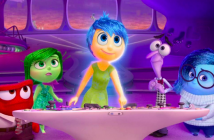
Editors Notes: V/H/S 2 opens theatrically this Friday, July 12th. Check local listings for showtimes.
The work of a series of young artists, V/H/S is the logical endpoint of the found footage horror subgenre. This subgenre originating not with the most widely known of them, 1999’s The Blair Witch Project, but rather can actually be traced all the way back to 1980’s Cannibal Holocaust. For the purpose of this essay, I’ll be focusing on this subgenre as it pertains to the millennial generation and how V/H/S represents quite possibly the best that this subgenre could be, not necessarily in dramatic structure, but in overarching thematic intuition. Despite a very cold critical reception, I find more worth in the 116 minutes of V/H/S than I’ve found in nearly any other horror film I’ve ever seen. I’ll concede upfront that I’m not the biggest fan of the horror genre. Not that I have any real objections to it, or that I think it lacks the artistic merit to stand beside classic drama or comedy. The justification is a much more mundane one in that they simply don’t do much for me as a viewer. They don’t really scare me or provide that type of brooding thrill the genre’s fans crave. I’m fond of several of them, but as pure genre exercise they often fail to resonate to any significant degree.
That said, I’ve found myself enamored with the found footage subgenre that has picked up a powerful head of steam in the past decade. Recalling nostalgic searches into old cardboard boxes and discovering unlabeled VHS tapes, popping them into the ancient device that plays them and eagerly anticipating the resulting images is something I think we can all relate to on some level. When videocameras became commercially viable for the less well off, everything needed to be recorded. Vacations, birthday parties, a child’s first steps — an extension of the still camera that included sound would insure the legacy of your most cherished memories. No longer would you be left to speculate about the context of an old photograph you don’t remember taking. The whole experience was recorded, and now you could relive it again and again with no fog or haze of memory. Nothing keeping you from really experiencing those precious moments. The millennial generation has taken this a step further with the ubiquitous presence of cameras of all shapes and sizes. They record not just their vacations and birthday parties, but their everyday life.

In David Bruckner’s “Amateur Night”, a young man wields a pair of thick glasses equipped with a tiny camera he and his friends plan to use to record their wild night out and the women they plan to conquer. The young man in the glasses is impressionable and perhaps even a bit reticent, but a willing participant nonetheless. At the bar, they encounter two women. One is drunk and playing along with the guys, but the other remains on the side. She’s timid, and sober. Her eyes are wide and her visage innocuous. She attempts connection with the young man in the glasses, but her hushed whispers fail to penetrate the thick fog of drunken delirium that encapsulates him. Upon returning to the hotel, one man begins to kiss the more bolder woman and gradually they remove each other’s clothing. As the man lays her down and sex seems inevitable, she loses consciousness and the third member of the group sits laughing on the couch. Through his uproarious laughter, he takes occasion to decry his friend’s advances toward the unconscious woman. Only at this point does the man cease seducing her and attempts to wake her with a violent shake. This action is not for her benefit, but rather so he can accomplish what he’d set out to do and the more timid young man could film it for their sake with his invisible camera. Her agency as willing participant is complicated by the young man’s constant surveillance. She was no doubt consenting to the activity between her and the man she was engaged with, but her gradual descent into a drunken stupor begins to erode the fabric of lucidity and ability to consent to potentially dangerous behavior. After she is no longer a participant, the mens’ gaze shifts toward the wide-eyed woman sitting in the adjacent bed, watching silently as they attempt to forcefully awaken her for the sake of plausible deniability. As soon as this character is introduced earlier on, she seems aware of the foul play involved, though to what extent is unknown. She doesn’t hoot and holler and jump to have sex. Instead, she sits in the margins like the muted conscience of the men, and after she is seduced by two of the young men, she begins taking aggressive control, flipping the predatory man who was rebuffed earlier on his back and bringing the camera-wielding friend she claimed fondness for into the mix. When the third guy sees this, he takes this as cue that he can get involved and begins undressing, at which point she screams “No!” and begins tearing into the flesh of the man beneath her. She exerts complete control in a breathtaking reversal of fortune that is made all the more potent by the film’s horror framework. She kills two of the young men, but as she pursues the smaller one she was actually interested in, she steps back and begins to weep. Even in the face of such overwhelming exploitation, she sees a more palpably moral individual in him, and after chasing him out of the hotel, she sprouts wings and flies away with him. That there could exist such a bizarrely tender moment of romanticism and it be successful is certainly a testament to the talent of David Bruckner in realizing this particular narrative.

Ti West’s “Second Honeymoon” tackles the issue of female agency in a less potent manner, though it remains a good short film in its own right. Sam and Stephanie’s trip serves to undermine a failing relationship. Though they initially appear happy, Sam’s sexual aggression early on in which he attempts to goad Stephanie into having sex with him on camera reveals the cracks in the power balance of their relationship. He’s not physically abusive, but he subtly objectifies her in one of the more discomforting moments of grounded gender drama in the overall film. After a young woman appears and asks for a ride, he reveals the story to Stephanie, who by now has taken the reigns as ersatz director, and speaks of thinking something was wrong and that he was concerned. As he and Stephanie discuss it and the woman disappears from the area, she asks if he’s going to call the cops. Further revealing a deeper lack of empathy and dangerous male pride, he refuses and claims he wouldn’t know what to say. The intruder, who later turns out to be Stephanie’s secret lover and the same woman who asked for the ride, films Stephanie’s butt with a voyeuristic eye and casually drags a switchblade along her thigh as she sleeps. Sam is not subjected to the same scrutiny. After the film starts to come to a conclusion with Sam’s death and the reveal of Stephanie’s secret romance, the footage cuts in and out and at the very end we see Stephanie driving a car and asking her passenger if she’s erased all of the footage. The discomfort I felt when witnessing Stephanie’s exploitation by Sam, and the subsequent caressing of her buttocks with a knife is given some difficult new context in regards to the issue of her exploitation. After being caressed by the knife, she instinctively pulls the covers up but doesn’t see fit to explore the reason for the sensation she felt. Did she know it was her girlfriend? Did she think it was Sam? If so, is this kind of behavior normal for him? Following this, “Second Honeymoon” becomes feminist revenge fantasy with a tinge of homosexual shame.
Glenn McQuaid’s “Tuesday the 17th” is the most ambitious of the bunch in pure thematic terms. Its narrative execution isn’t particularly smooth, perhaps due in part to the compact runtime, but it stands out among the omnibus for its depiction of fractured memory and the fragility of recorded reality. Taking a quick cue from the previous films, this one begins with a voyeuristic male using his handheld camera to peer at the breasts and genitals of a female friend. She assures him and the other male present that she’d never have sex with them, deflating the camera-wielder’s ego and leading him to refer to her as a “crack whore” as they begin to enter the woods at their destination. His camera intermittently flashes images of corpses he seems confused by. One of the younger women reveals that on a previous occasion, a few people were murdered while she was present, then laughs it off to dissuade further investigation by the other three. When the murderer is revealed, the camera ceases to capture a clear image, resulting in the recorded image of what amounts to a series of scrambled pixels due to tracking errors. After two of them are killed and the man originally holding the camera is told he and the rest were brought there as bait so she could capture footage of the murderer that nobody believed existed, this elusive and imageless killer chases her and stabs her. As she wanders about the forest, bleeding out, she cries out that this was all for nothing. The irony at the heart of this being that even if she’d survived, her footage would have revealed nothing useful. The fragility of her VHS camcorder had distorted the image of her killer beyond recognition. Her memory of a killer is now gone completely in spite of her attempt to use the camcorder to validate it. For all intents and purposes, this man no longer exists. Though they may discover the young individuals’ bodies, the killer is nothing but an artifact on an old piece of technology.

Joe Swanberg’s “The Sick Thing That Happened to Emily When She Was Younger” uses not VHS technology as an aesthetic framework, but rather that of a webcam. The film’s frame is a videochat screen, with James, the doctor-to-be in the bottom right corner and Emily taking up most of the image space. Being that she is the target of James’ manipulation, it seems fit to position her as the protagonist in her own nightmare. Wendy hears noises and sees things, which James takes as occasion to assert his masculine authority over an allegedly mentally fragile Wendy. She insists he record their chat to validate her experiences, but he conveniently forgets. Though the apparatus sees the aliens or ghosts, diegetically it’s a non-starter for reassuring Emily due to James’ refusal to hit a simple button. This inherent barrier in the basic properties of recording devices is James’ weapon of choice in keeping Emily in a desperate state and yearning for his comfort and an objective viewpoint. This cognitive dissonance leads her, after having an alien fetus removed from her by James who is actually living close by despite telling her otherwise, to a doctor who diagnoses her with schizo-affective disorder, invalidating her haunting experiences and granting James even stronger authority over his medical subject. After signing off with Emily post-abortion, he switches feeds to another woman in the same position. And just to add to his sleaze, he asks this woman to remove her clothes as they chat surreptitiously. Echoes of Chat Roulette, the chat service notable for the remarkable amount of men trolling it with their penises in hand, ring throughout and bring this form of internet misogyny to a very real center stage.
Radio Silence’s “10/31/98” is easily the best of the bunch as a true horror film. Fitted with a nanny cam in a bear suit similar to the glasses in the first segment, a man and his friends head to a Halloween party. Upon arrival, they realize nobody’s actually home. Instead of leaving, they assume it’s a haunted house and see fit to form their own fictional world in the midst of the most unrepentant break-in possible. An empty house is now the playground for the party-goers, who survey the home with their camera in search of thrills. The house begins to come alive in ways they assume are part of the act, but as they ascend the staircase to the attic, they witness a sacrificial scene they again think is part of the joke. A handful of men surround a woman tied up screaming for help chanting some kind of incantation. Despite the screaming woman’s pleas, the men continue playing along and eventually join the chorus which alerts the men to their presence. They’re scared away from the attic and rush out of the house in the midst of flying debris, hands reaching out of walls and some other genuinely unsettling imagery. Right before leaving, the man with the camera’s better nature kicks in and he asks that they go back and save the girl. This last ditch attempt at nobility proves futile when the woman turns out to be a ghost of some kind and phases out of the car after stopping its engine, stranding the boys on a train track. The revenge fantasy continues.
The film’s framing narrative, Adam Wingard’s “Tape 56” begins the film with a brilliant bang of quick edits and frantic, destructive energy. An energy exerted by yet another group of young men. These men earn money by preying on attractive women in the street and molesting them, forcing them to expose themselves and selling the footage. A sledgehammer indictment of youth female objectification that kickstarts the film’s exploration of agency, consent and the digital age of homebrewed surveillance. The framing narrative as a whole doesn’t serve much beyond this initial burst, and is largely just an impetus for the omnibus. In a world in which nothing is truly private, the objectification of women in a supposedly enlightened era rages on. At what point do we cease being onlookers and start becoming enablers? In the public sphere, everything is filmable and everything is subject to extra scrutiny. Be you a willing participant or not, you’re now an actor on the grandest stage of them all: the internet.



